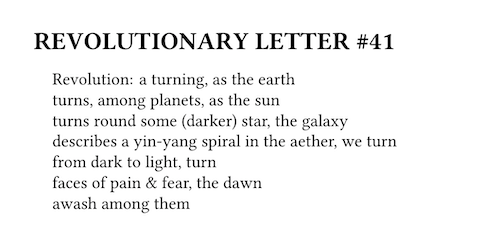The Revolutionary Diane di Prima Dies at 86
We're devastated to share the news that Diane di Prima, the legendary poet, activist, crucial lifeline to the Beat generation and eventual Poet Laureate of San Francisco, has died at the age of 86. Her Revolutionary Letters, originally published in 1968 and dedicated to Bob Dylan, is forthcoming from City Lights in an expanded edition. While she authored more than a dozen books, you can find a handful of those published by City Lights, including Memoirs of a Beatnik, Pieces of a Song: Selected Poems, and Loba, here. In a brief post last night, for "[a] magic woman, an extraordinary woman," the Allen Ginsberg Project shared links to several of di Prima's readings:
Here’s her reading at the Bay Area Writers series in Novato in 1976 – here and here
Here’s Diane reading alongside Allen and Anne Waldman at Naropa in 1974 – here
Here‘s Diane reading in San Francisco’s Golden Gate Park, alongside the late great Michael McClure
and here’s Diane at Naropa in 1978 from Constanzo Allione”s film Fried Shoes Cooked Diamonds (reading the dedication to her book Revolutionary Letters)
At Stanford's Book Haven blog, Cynthia Haven shares a recollection by Hilton Obenzinger:
After she dropped out of college she spent half the day writing and half studying. “I took the agenda, more or less, that Pound proposed, and taught myself some Homeric Greek so I could sound out the poems.” She also studied classical Greek grammar and Latin. “I’d study usually at home, and then I’d take my notebook and go out and write, run around the city and write. And then the typing and revising happened at home in the evening. We needed very little, so $70 a month covered the rent. The house was $33, the apartment—four of us lived in it. It was a cold-water flat. No heat. Bathroom in the hall.” Her bohemian lifestyle flowed from her commitment to her art—not the other way around.
Thinking or composing “as it happens” is something that poet Diane di Prima tried early in her career. Jack Kerouac stayed at her place in New York on the way to India in February 1957. With Ginsberg, Kerouac, and others in her small apartment, everyone started to read their poems out loud.
They read their poems together.
After she read one of hers, Kerouac asked, “What did it look like when you first wrote it?” She looked at her early draft, and to her surprise she liked it. What she got from that experience was the knowledge that “you could always go back to those drafts and pull something out when you got stuck, you know; and then I got the sense of how your mind worked in the first place, and that was very interesting.” She had taken a class on dance composition with a choreographer, who implanted the idea that everything has a form—everything. “He said nothing else. After about ten minutes we all started to go out the door,” di Prima said. “We were looking at everything. Oh, that has a form; that has a form. He was telling us that all forms are okay. Leave your mind alone. Don’t mess with everything all the time.” As a consequence, she began following her mind in her writing wherever it went: “Write exactly what’s happening as closely as you can.”
Tributes are flowing on Twitter; and we'll keep our eyes out for more.
Our hearts go out to di Prima's family, friends, and community. She will be greatly missed.



